 2010
2010
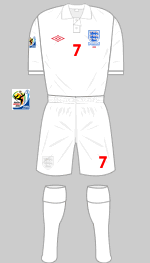
2010 World Cup
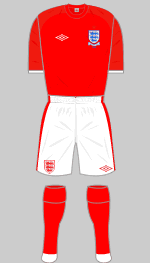
2010 Change

2010 World Cup Change
Designer: Umbro
England's new red change kit was farcically launched in Paris at a concert by Kasabian in February 2010, where it was met, understandably by a rousing chorus of booing. Although clearly inspired by the iconic 1966 World Cup final strip, the effect was rather spoiled by the prominent white cuffs (which are even more pronounced on the long-sleeved version. The sleeves and shoulders were a slightly darker red than the main body and a single star (signifying England's solitary World Cup win) was embroidered above the crest. The stripe on the shorts sloped to the rear rather than following the seam as is traditional and the England crest appeared in red.
Replicas prepared for the 2010 FIFA World Cup had "South Africa" embroidered below the FA crest in place of the individual opponents. The all-red alternate version was used during the tournament against Slovenia and Germany.
 2010-2012
2010-2012
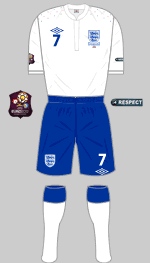
2010-2012

2010-2011 Change
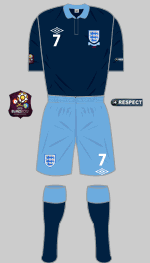
2011-2012 Change
Designer: Umbro
After England's disappointing performance in South Africa, a change of strip for the European Championship was, perhaps, a welcome development even if it did break the normal cycle of two-year shelf lives for new strips. Worn for the first time at Wembley against Bulgaria on 3 September, dark blue shorts were reinstated, in a rather richer shade than the traditional navy. The only red featuring on the shirt was in the date printed below the FA crest and in the tiny crosses of St George in red, blue, green and purple across the shoulders. These are intended "to reflect a culturally diverse modern England" according designer Peter Saville, formerly of Factory Records.
The introduction of a new change kit in the summer of 2011 in two shades of blue attracted even more criticism and was accompanied by a goalkeeper's kit, made up of interlocking St George's crosses in various shades of green that defied belief.
 2012-2013
2012-2013
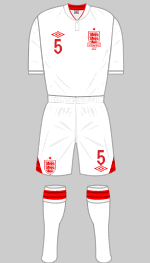
2012-2013
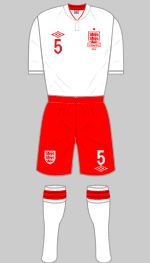
15 Aug 2012
v Italy
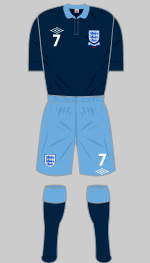
2012 Change
Designer: Umbro
After openly criticising the FA in the Italian media over the decision to strip John Terry of the captaincy pending Terry's trial for alleged racial abuse, Capello resigned in February 2012. This controversy perhaps explains the low-key launch of the new England strip later that month. There were also those who criticised the FA for commercial greed, with the introduction of the third new "home" strip in two years, cashing in on England's qualification for the Euro 2012 finals. There is no denying that the new, all-white look was a radical - and brave - departure. For the first time there was no blue in the kit whatsover, the red-and-white theme instead referencing the flag of St George. The striped motif on the reverse inside collar (repeated underneath the collar flaps on the front) was inspired by the striped trim on Sir Alf Ramsey's jacket worn in 1966. The team wore red shorts in a friendly against Italy played in Berne.
 2013-2014
2013-2014
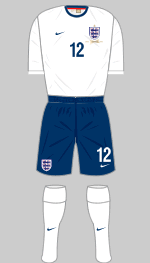
2013-2014
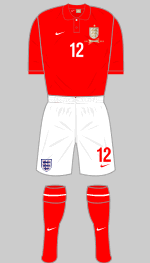
2013-2014 Change
Designer: Nike
In August 2012, the FA signed a five-year contract with Nike worth a reported £20m a year and two months later, Nike sold Umbro to the US based Iconix Brand Group for £140m. Umbro made their displeasure obvious by taking out an advertisement prior to the last appearance of their kit against Brazil in February 2013 showing photographs of the different strips they have made for England with the caption, "For over 50 years we just did it," a play on the Nike slogan, "Just do it."
The first kits to carry the Nike swoosh were worn against the Republic of Ireland on 29 May and also carried a specially designed crest that marked the 150th anniversary of the FA. The ribbon underneath the badge carries the legend 1863 - 150 years - 2013 and replaced the usual match information.
 2014-2015
2014-2015
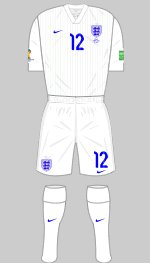
2014-2015
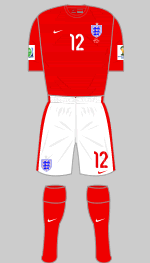
2014-2015 Change
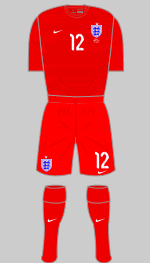
2014-2015 Alt Change
Designer: Nike
Once England qualified for the 2014 World Cup in Brazil, it came as no surprise that Nike and the FA introduced two new strips: the first choice was in all-white with silver detailing to comply with FIFA's new requirements for the tournament that each team register one predominantly light strip and a second predominantly dark one. What did come as a surprise was that Nike adopted the variable pricing model is use in north America. "Match Edition" shirts, incorporating all the technology that Nike could cram into it, retailed for £90 while "Stadium" versions cost £60, the new going rate for replicas. Junior versions came in at £35-£40.
All-red was worn in European Championship qualifiers against Slovenia and San Marino in 2015.
 2016-2017
2016-2017
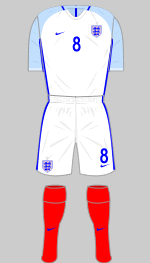
2016-2017
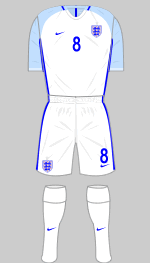
8 October 2017
v Lithuania
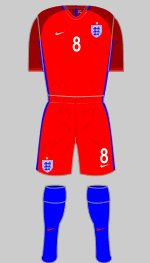
2016 Change
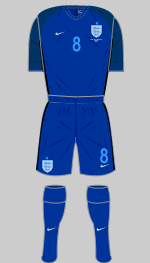
2017 Third
Designer: Nike
Nike's new set, introduced in time for Euro 2016, were in their latest "Vapor" design and were met with considerable hostility. As a rule of thumb football strips look their best when they consist of two dominant colours with a third accent colour: four colours rarely look good (Brazil are of course the exception). The ice blue and dark red sleeves just don't reference anything in England's history and simply looked wrong. Furthermore Nike foisted the same design on several of the national teams they were contracted to including the USA and Brazil, suggesting that Nike's brand is more important than the traditions of the football federations they serve.
The best that could be said for the new third kit, debuted against Germany in March 2017, is that it was an improvement on the change kit. Still in the vapid Vapor template, the violently contrasting socks were gone and the accent colours (silver and light blue) confined to detailing. On the other hand, England's record while wearing blue was hardly inspiring. Blue was, of course, the team's original choice for change shirts but was banished after the humiliating defeat against the United States in 1950.
 2018-2019
2018-2019
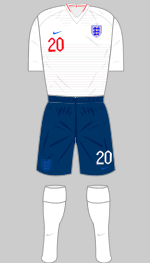
2018-2019
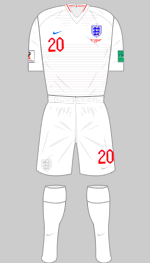
2018 World Cup
v Croatia 11 July
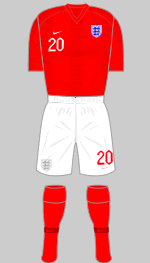
2018-2019 Change
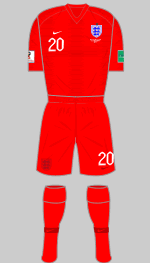
2018 World Cup Change
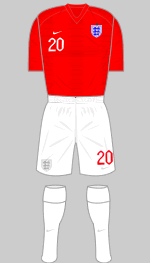
14 October 2019
v Bulgaria
Designer: Nike
Following on from the unpopular Vapor design, Nike went for something more traditonal ahead of the World Cup in Russia. A St George's cross motif in red featured in the neckline of the first shirt while the red alternative had a large cross subtly embossed into the front in the odd scratch pattern that Nike introduced as trim on the sleeves and shoulders of their new tops. An interesting touch was to have the applications on the shorts and socks sublimated into the fabric giving the strip a classic, uncluttered look. The all-red strip was worn twice in the World Cup against Tunisia and then Sweden. England had a god tournament, reaching the semi-finalsw where they were beaten by Croatia in extra-time before going on the lose to Belgium in the third place play-off.



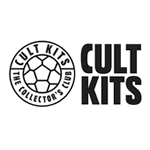
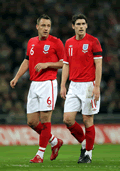 With Fabio Capello in charge of the team, England qualified for the 2010 World Cup in South Africa with some ease but were disappointing in the tournament itself. Injury prevented David Beckham from appearing in his fourth World Cup finals and in August Capello announced to the press that the former captain's international career was over. Cappello resigned in February 2012 after a dispute with the FA and was replaced by Roy Hodgson. Sam Allardyce took over in July 2016 but resigned just 67 days later over an allenged breach of FA rules. Gareth Southgate, who coached England's Under-21 side, was put in temporary charge before being awarded a four-year contract to coach the senior team.
With Fabio Capello in charge of the team, England qualified for the 2010 World Cup in South Africa with some ease but were disappointing in the tournament itself. Injury prevented David Beckham from appearing in his fourth World Cup finals and in August Capello announced to the press that the former captain's international career was over. Cappello resigned in February 2012 after a dispute with the FA and was replaced by Roy Hodgson. Sam Allardyce took over in July 2016 but resigned just 67 days later over an allenged breach of FA rules. Gareth Southgate, who coached England's Under-21 side, was put in temporary charge before being awarded a four-year contract to coach the senior team.









 2014-2015
2014-2015










